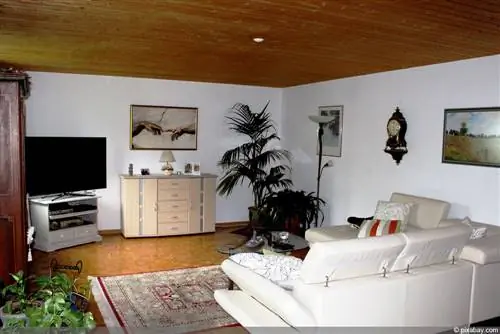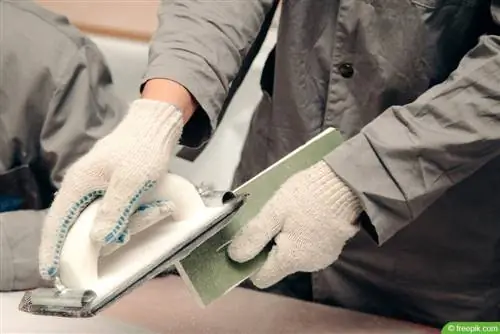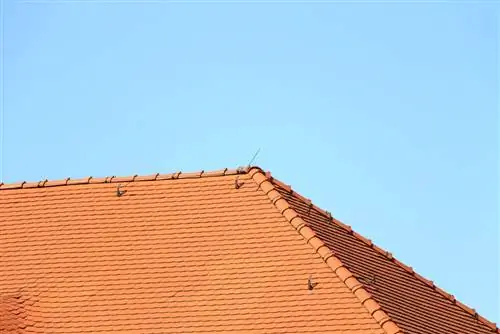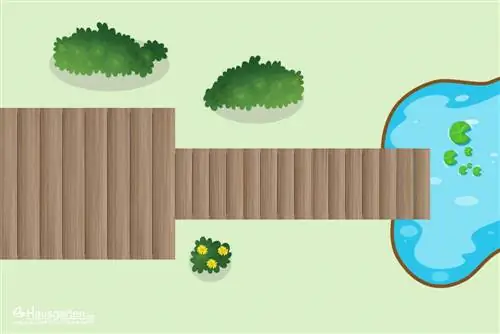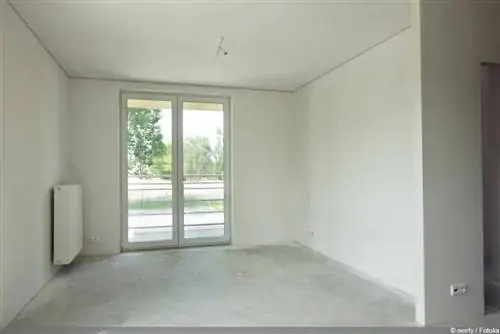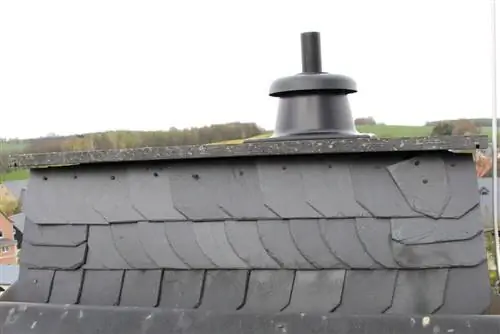- Author admin [email protected].
- Public 2023-12-17 03:39.
- Last modified 2025-01-24 12:45.
Old wooden ceilings have their charm, but they often seem a bit staid or require extensive refurbishment. As an alternative to demolition, you can design wooden ceilings with plasterboard. You get a smooth ceiling that you can paint or cover with wallpaper. The effort is low and the costs are moderate, so you should include this alternative to demolition in your considerations.
Note the height of the wooden ceilings
If you plan to cover the wooden ceilings with plasterboard, you should take into account in advance that this will reduce the height of the ceilings. This is particularly serious if there is insulation under the wooden ceiling, which is particularly common in older houses. If the room is already very low due to the wooden paneling being attached to the ceiling, you should take into account that the height will be reduced by another centimeter. This plays a minor role in the livability of the room. However, if you have installed cabinets that reach to the ceiling, this furniture may no longer fit in the room once covered and will need to be shortened or placed in another room.
Check the durability of the substructure
Gypsum boards have a low weight, but they still have a total weight of 7.5 kg to 10 kg per square meter. Before deciding to design the ceiling with plasterboard, you should check whether the substructure can support this weight. It must be avoided at all costs that the structure falls from the ceiling again because it does not receive sufficient support.
Check the condition of the wooden panels
It is very important that you check the condition of the wooden panels. Before you invest in the plasterboard, it is very important that you take a close look at the nature of the wood. If in doubt, it is recommended that you seek the opinion of a professional. If the wood is moldy or has become porous due to woodworm infestation, cladding makes little sense because it could become unstable. Only if the wood is in optimal condition and has a high ability to support weight should you choose cladding.
Formation of condensation under the wooden panels
If you ask a professional for advice, they will often recommend removing the wooden ceiling. The background is that the wall structure changes when the plasterboard is attached. Condensation can form. This condensation water attacks the wood, but also the walls. After a few years you notice unsightly stains and have to remove the entire structure. Before covering the ceiling, inspect the walls for damp areas and, if necessary, look for the cause. If there are damp spots on the ceiling or adjacent wall, you must dry them out before cladding.
Wood as a natural raw material
Wood is a natural raw material that works. This can cause cracks to appear in the plasterboard construction over time. If you have covered the ceiling with wallpaper, these cracks may become visible. There's not much you can do about the changes in the wood. If the ceiling is very dry and porous, it helps to apply an oil or paint before covering it to close the pores somewhat. This will help you prevent cracks from forming in your new ceiling.
Check the attachment of the ceiling panels
Checking the stability of the wooden ceiling is very important. The wood can be screwed to the ceiling, which is very stable. Here you can do the cladding without any worries. However, if the wood is only attached to the ceiling with small clamps and not screwed, it is recommended that you fix the wood with screws before fixing the plasterboard.
Calculate the need for work materials
Before you can actually start cladding the wooden ceilings, it is important that you determine the work materials you need. To do this, measure the length and width of the wooden ceiling and calculate the area in square meters that you want to cover. Plasterboard is available in different dimensions. This means you can adapt your needs very well to your project and not have too much waste.
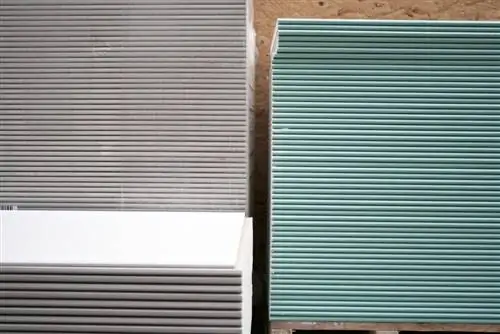
For the cladding you will also need screws, the length of which should be such that the plasterboard holds securely to the ceiling. Dowels are not necessary because plasterboard is a soft material into which you can screw the screws directly.
Get the tools ready for the paneling
It is an advantage if you have the tools ready before starting your work. This saves you time because you have everything you need right at hand. You will need the following tools to work on the ceiling:
For cutting the plasterboard:
- Cutter knife or small circular saw
- large table or trestle table
- Tape measure, ruler and pencil
For attaching the plasterboard to the ceiling:
- safe ladder
- Screwdriver or
- Cordless screwdriver
It is recommended that you use a powerful cordless screwdriver. Depending on the size of the blanket, you will work with your hands raised for several hours. Screwing the panels together manually can be very tiring.
Cutting the plasterboard panels
In most cases it will be necessary to cut the plasterboard to size. It is an advantage if you carry out this step before you start the actual fastening. If possible, you should do the cutting outdoors, in a garage or in a workshop. When cutting, a light-colored dust forms that settles on the furniture if you cut directly in the room where you want to create the ceiling. Screwing the panels to the ceiling wood leaves no residue, so you don't necessarily have to move the furniture out of the room.
The cut:
- Calculate the required length and width of the individual panels, based on the ceiling size
- Draw a mark on the cut edge
- Make the crop
It is an advantage if you mark the future position of the individual panels. You can use numbers for this. This is especially true if the ceiling is not completely straight, which is particularly common in older houses. Then you need panels with a special cut for the cladding. You will find these more easily if they are marked with a number.
Screwing the plasterboard to the wooden ceiling

Start at one corner of the room and work your way piece by piece with the cut panels to the other corner of the room. It is recommended that you place a screw approximately every ten centimeters to ensure that the structure is securely held. Make sure that you place the plasterboards edge to edge. There should be no unsightly gap between two plates.
Grouting edges
After attaching the panels, you will see that visible abutting edges have formed. This cannot be avoided due to the slightly curved shape of the plasterboard. Grout these abutting edges with plaster. This results in a uniform, smooth ceiling construction.
Cover the corners of the room with end strips
Unsightly joints can appear at the corners of the room due to the cutting of the plasterboard. If you want a uniform construction, opt for attaching end strips. These are attached to the ceiling with small nails and are available in many different designs. This gives you a uniform ceiling construction that also looks very appealing.
Design of the new ceiling
Once you have completed the work on the ceiling, you will receive a uniform and smooth white surface that you can now design according to your preferences. Rigips can be easily covered with wallpaper. They use classic wallpaper paste, which bonds perfectly to the surface of the plasterboard. Wallpapering is so easy.
Alternatively, you can also paint your new ceiling. However, if you choose this option, it is important that you have the joints closed perfectly. Imperfections would be clearly visible under the paint while they would disappear under the wallpaper. The combination of a woodchip wallpaper and a coat of paint is of course also possible.

